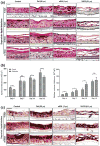Delphinidin, a dietary antioxidant, induces human epidermal keratinocyte differentiation but not apoptosis: studies in submerged and three-dimensional epidermal equivalent models
- PMID: 23614741
- PMCID: PMC3777415
- DOI: 10.1111/exd.12140
Delphinidin, a dietary antioxidant, induces human epidermal keratinocyte differentiation but not apoptosis: studies in submerged and three-dimensional epidermal equivalent models
Abstract
Delphinidin (Del), [3,5,7,3'-,4'-,5'-hexahydroxyflavylium], an anthocyanidin and a potent antioxidant abundantly found in pigmented fruits and vegetables exhibits proapoptotic effects in many cancer cells. Here, we determined the effect of Del on growth, apoptosis and differentiation of normal human epidermal keratinocytes (NHEKs) in vitro in submerged cultures and examined its effects in a three-dimensional (3D) epidermal equivalent (EE) model that permits complete differentiation reminiscent of in vivo skin. Treatment of NHEKs with Del (10-40 μm; 24-48 h) significantly enhanced keratinocyte differentiation. In Del-treated cells, there was marked increase in human involucrin (hINV) promoter activity with simultaneous increase in the mRNA and protein expressions of involucrin and other epidermal differentiation markers including procaspase-14 and transglutaminase-1 (TGM1), but without any effect on TGM2. Del treatment of NHEKs was associated with minimal decrease in cell viability, which was not associated with apoptosis as evident by lack of modulation of caspases, apoptosis-related proteins including Bcl-2 family of proteins and poly(ADP-ribose) polymerase cleavage. To establish the in vivo relevance of our observations in submerged cultures, we then validated these effects in a 3D EE model, where Del was found to significantly enhance cornification and increase the protein expression of cornification markers including caspase-14 and keratin 1. For the first time, we show that Del induces epidermal differentiation using an experimental system that closely mimics in vivo human skin. These observations suggest that Del could be a useful agent for dermatoses associated with epidermal barrier defects including aberrant keratinization, hyperproliferation or inflammation observed in skin diseases like psoriasis and ichthyoses.
© 2013 John Wiley & Sons A/S.
Conflict of interest statement
Figures




Similar articles
-
Prodifferentiation, anti-inflammatory and antiproliferative effects of delphinidin, a dietary anthocyanidin, in a full-thickness three-dimensional reconstituted human skin model of psoriasis.Skin Pharmacol Physiol. 2015;28(4):177-88. doi: 10.1159/000368445. Epub 2015 Jan 22. Skin Pharmacol Physiol. 2015. PMID: 25620035 Free PMC article.
-
Delphinidin, an anthocyanidin in pigmented fruits and vegetables, protects human HaCaT keratinocytes and mouse skin against UVB-mediated oxidative stress and apoptosis.J Invest Dermatol. 2007 Jan;127(1):222-32. doi: 10.1038/sj.jid.5700510. Epub 2006 Aug 10. J Invest Dermatol. 2007. PMID: 16902416
-
Topical application of delphinidin reduces psoriasiform lesions in the flaky skin mouse model by inducing epidermal differentiation and inhibiting inflammation.Br J Dermatol. 2015 Feb;172(2):354-64. doi: 10.1111/bjd.13513. Epub 2014 Dec 23. Br J Dermatol. 2015. PMID: 25533330 Free PMC article.
-
Delphinidin, a dietary anthocyanidin in pigmented fruits and vegetables: a new weapon to blunt prostate cancer growth.Cell Cycle. 2008 Nov 1;7(21):3320-6. doi: 10.4161/cc.7.21.6969. Epub 2008 Nov 9. Cell Cycle. 2008. PMID: 18948740 Free PMC article.
-
Keratinocyte proliferation, differentiation, and apoptosis--differential mechanisms of regulation by curcumin, EGCG and apigenin.Toxicol Appl Pharmacol. 2007 Nov 1;224(3):214-9. doi: 10.1016/j.taap.2007.03.020. Epub 2007 Mar 30. Toxicol Appl Pharmacol. 2007. PMID: 17493651 Free PMC article. Review.
Cited by
-
Protective effect of tropical highland blackberry juice (Rubus adenotrichos Schltdl.) against UVB-mediated damage in human epidermal keratinocytes and in a reconstituted skin equivalent model.Photochem Photobiol. 2013 Sep-Oct;89(5):1199-207. doi: 10.1111/php.12104. Epub 2013 Jul 8. Photochem Photobiol. 2013. PMID: 23711186 Free PMC article.
-
Fisetin, a 3,7,3',4'-Tetrahydroxyflavone Inhibits the PI3K/Akt/mTOR and MAPK Pathways and Ameliorates Psoriasis Pathology in 2D and 3D Organotypic Human Inflammatory Skin Models.Cells. 2019 Sep 15;8(9):1089. doi: 10.3390/cells8091089. Cells. 2019. PMID: 31540162 Free PMC article.
-
Caspase-14-From Biomolecular Basics to Clinical Approach. A Review of Available Data.Int J Mol Sci. 2021 May 25;22(11):5575. doi: 10.3390/ijms22115575. Int J Mol Sci. 2021. PMID: 34070382 Free PMC article. Review.
-
Delphinidin diminishes in vitro interferon-γ and interleukin-17 producing cells in patients with psoriatic disease.Immunol Res. 2022 Apr;70(2):161-173. doi: 10.1007/s12026-021-09251-y. Epub 2021 Nov 25. Immunol Res. 2022. PMID: 34825313
-
Graviola (Annona muricata) Exerts Anti-Proliferative, Anti-Clonogenic and Pro-Apoptotic Effects in Human Non-Melanoma Skin Cancer UW-BCC1 and A431 Cells In Vitro: Involvement of Hedgehog Signaling.Int J Mol Sci. 2018 Jun 16;19(6):1791. doi: 10.3390/ijms19061791. Int J Mol Sci. 2018. PMID: 29914183 Free PMC article.
References
Publication types
MeSH terms
Substances
Grants and funding
LinkOut - more resources
Full Text Sources
Other Literature Sources
Medical
Miscellaneous

